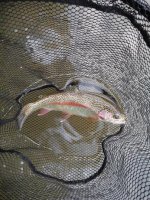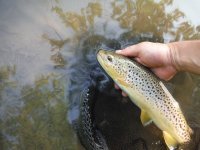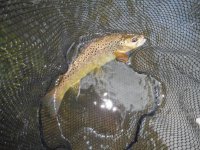3wt7X
Active member
- Joined
- Nov 19, 2008
- Messages
- 670
The dry dropper combo with a weighted nymph has long been my go to on Cumberland Valley Limestoners. I believe that the presentation best allows you to nymph skiddish fish from a distance and the delicate landing of the dry along with enhanced strike detection goes far beyond many other nymphing techniques in streams such as Big Spring, Letort, Falling Springs and Beaver Cr. Additionally, I think we often miss out on some nice shallow holding lyes in those streams using the standard czech nymph/high stick presentation.
I was out this morning, early morning, and I tried something new using the dry dropper that I would like to share. My usual tactic for that technique is to work the shallow runs and pocket water, allowing the dry to spin in the pockets with the dropper about a foot below. Today, early am around 6:30 I came to a slow bend hole that does not even contain a riffle. I lengthened my leader to about 12 foot and tyed a weighted scud about a full 2 foot below a high riding caddis pattern. I was able to achieve a long slow 40 foot drift and I started to experiment by twitching the rig several times to immitate motion in both the caddis and scud. It really produced as I tricked about 8 nice trout in a 30 minute span to include a healthy wild 13 inch rainbow and a heavy 15 inch brown. The takes were coming shortly after the twitch. Regardless, never overlook the dry dropper on limestone trout. Good Luck!!!
I was out this morning, early morning, and I tried something new using the dry dropper that I would like to share. My usual tactic for that technique is to work the shallow runs and pocket water, allowing the dry to spin in the pockets with the dropper about a foot below. Today, early am around 6:30 I came to a slow bend hole that does not even contain a riffle. I lengthened my leader to about 12 foot and tyed a weighted scud about a full 2 foot below a high riding caddis pattern. I was able to achieve a long slow 40 foot drift and I started to experiment by twitching the rig several times to immitate motion in both the caddis and scud. It really produced as I tricked about 8 nice trout in a 30 minute span to include a healthy wild 13 inch rainbow and a heavy 15 inch brown. The takes were coming shortly after the twitch. Regardless, never overlook the dry dropper on limestone trout. Good Luck!!!






